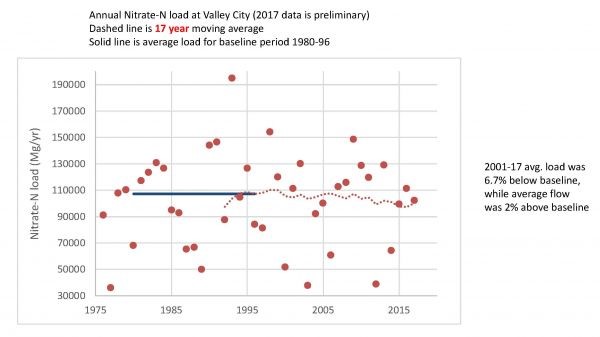In case you missed the headlines in the national papers, the Gulf of Mexico Hypoxic Zone was the largest in recorded history this summer. Yes, that’s the bad news.
The good news is, despite high flows and large nitrate-nitrogen (nitrate-N) loads in the Illinois River in April and May, the 2017 yearly nitrate-N loading in the river was about 5% lower than the 1980-96 baseline average load.
The 1980-96 baseline is important because it serves as the reference point for IL-EPA’s requested reductions of 45% for nitrate nitrogen and total phosphorus loading to the Gulf of Mexico by 2035. Illinois has an interim goal of 15% load reduction in nitrate-N and 25% reduction in phosphorus by 2025.
The reduced nitrate losses to the river is good news since ag, along with municipal wastewater discharge, is known to be a primary source of nitrate-N in the IL river system.
The findings, published by U of I researchers Greg McIsaac, and Mark David and George Gertner, revealed that average annual nitrate-N loads in the Illinois River declined by 10% for the 5-year period from 2010-2014 relative to the 1980-96 baseline. By comparison, an updated 5-year average from 2013-17 revealed that nitrate-N loads in the River declined by 5.6% from baseline. The larger percentage reduction during 2010-2014 was largely due to the 2012 drought year when loads were abnormally low due to unusually low flow.

This graphic demonstrates yearly nitrate-N loads in the Illinois River along with the 1980-1996 baseline value and the 17-year running average value.
A correlation between reduced nitrate-N loads and net agricultural N inputs suggests that the reduced nitrate-N loads in recent years is likely the result of improved N use efficiency resulting from increased crop yields with little increase in N fertilizer input relative to the baseline period. There was not sufficient data on all conservation efforts to determine whether the reduced nitrate loads might also result from farmers employing practices such as side-dress N application and cover crops, which can also improve N fertilizer use efficiency.
There’s one more piece of pretty obvious bad news. Regardless of the time frame, none of the recent nitrate-N load reductions – 5.6% reduction from 2013-2017, 10% reduction from 2010-2014, 5% reduction for 2017 – are sufficient to meet the 15% reduction goal set by the IL-EPA for our 2025 interim goal, much less the 45% reduction goal for 2035.
What can we do to get us the rest of the way towards meeting these nitrate loss goals?
- Applying at least half of your nitrogen fertilizer in-season with the goal of coordinating fertilizer availability with crop uptake is one of the most important contributions you can make.
- Other practices including cover crops, rotations that include perennial crops, or converting unprofitable row-crop acres to perennial crops are first lines of defense for protecting our N fertilizer investment by reducing loss from fields.
- Edge-of-field practices like treatment wetlands, saturated buffers, and bioreactors can prevent lost N from making its way into our state and national waters where they create drinking water and environmental problems.
Let’s end with another piece of good news: Each of us can do something to reduce nitrate losses. Working together, we can meet the goals of the Nutrient Loss Reduction Strategy, improve local and national water quality, leave a legacy of improved soil quality, and thwart the need for additional regulation of agriculture in Illinois.
The 2016 study, “Illinois River nitrate-nitrogen concentrations and loads: Long-term variation and association with watershed nitrogen inputs,” written by Gregory F. McIsaac, Mark B. David, and George Z. Gertner, is published in the Journal of Environmental Quality. Updated analyses have not been published, but were presented at the Illinois Nutrient Loss Reduction Conference in November 2017.
Data used in the study was provided by the US Geological Survey and the US Department of Agriculture. Partial funding was provided by the Illinois Environmental Protection Agency and National Institute of Food and Agriculture, USDA, under Agreement No. 2011-039568-31127.
Laura Gentry, Ph.D., is the Illinois Corn Growers Association and Illinois Corn Marketing Board director of water quality science. Her works centers on watershed research to support agriculture water quality initiatives and nutrient management, with a primary responsibility being the Precision Conservation Management program.


 and then
and then